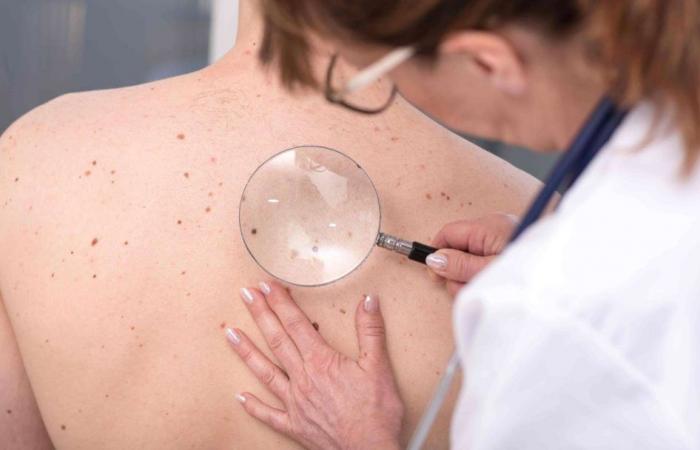Skin cancer is divided into two main types: carcinoma and melanoma. Carcinoma, including basal cell carcinoma and squamous cell carcinoma, is the most common and usually develops on areas of the skin exposed to the sun. Melanoma, although less common, is more aggressive and can spread quickly to other parts of the body. Early detection is therefore essential to improve the prognosis.
Signs of Basal Cell Carcinoma and Squamous Cell Carcinoma
Basal cell carcinomas (CBCCBC) are the most common forms of skin cancerskin canceraccounting for about 80% of cases. They occur mainly on areas of the skin regularly exposed to the sun, such as the face, neck and hands. Signs to watch for include:
- Pearly nodules: CBCs often appear as small bumps translucenttranslucent or pearly, sometimes with blood vessels visible on the surface.
- Persistent ulcers: An open sore that does not heal within a few weeks may be a sign of BCC. These ulcers may ooze or form a crustcrust.
- Red or irritated areas: Red, irritated, itchy or uncomfortable areas may also indicate BCC, especially if they do not respond to usual treatments for mild skin conditions.
Squamous cell carcinomas (CECCEC), less common than CBCs, are nevertheless important to identify early. They can appear in the same areas as CBCs but are often more aggressive. Signs include:
- Plaques scalyscaly : CECs often present as red, scaly patches with a rough or crusty surface.
- Firm nodules: Unlike the pearly nodules of CBCs, those of CECs are firmer and may have a rough surface.
- Warty lesions: SCCs may also resemble wartswartsespecially on the lips, ears and hands.
Signs of Melanoma
Melanoma is the most dangerous type of skin cancer because of its ability to spread quickly. It can occur anywhere on the body, including areas not exposed to the sun. soleilsoleilThe ABCDE rule is an essential tool for the detection of melanomas:
- A for Asymmetry: One half of the spot does not look like the other half.
- B for Borders: The borders of melanoma are often irregular, jagged, or blurred.
- it’s for ColorColor : Melanomas typically vary in color, including different shades of brown, black, sometimes red, blue, or white.
- D for Diameter: Melanomas are often larger than 6 mm, about the size of a pencil eraser, but they can be smaller when detected early.
- E for Evolution: Any change in the size, shape, color or symptoms (such as itching or bleeding) of a skin lesion should be taken seriously.
In addition to the ABCDE rule, any new skin lesion or change in an existing lesion. Melanomas can also appear as small brown or black spots on the nailsnailsthe soles of the feet or the palms of the hands.
Early recognition of the signs of skin cancer can save lives. Paying close attention to changes cutaneouscutaneous and prompt medical consultation in case of doubt are essential. Awareness and education about the warning signs can help detect skin cancers at an early stage, thereby significantly improving the chances of healinghealing. Do not hesitate to consult a dermatologistdermatologist for any suspicious lesion in order to benefit from a diagnosticdiagnostic and appropriate treatment.






